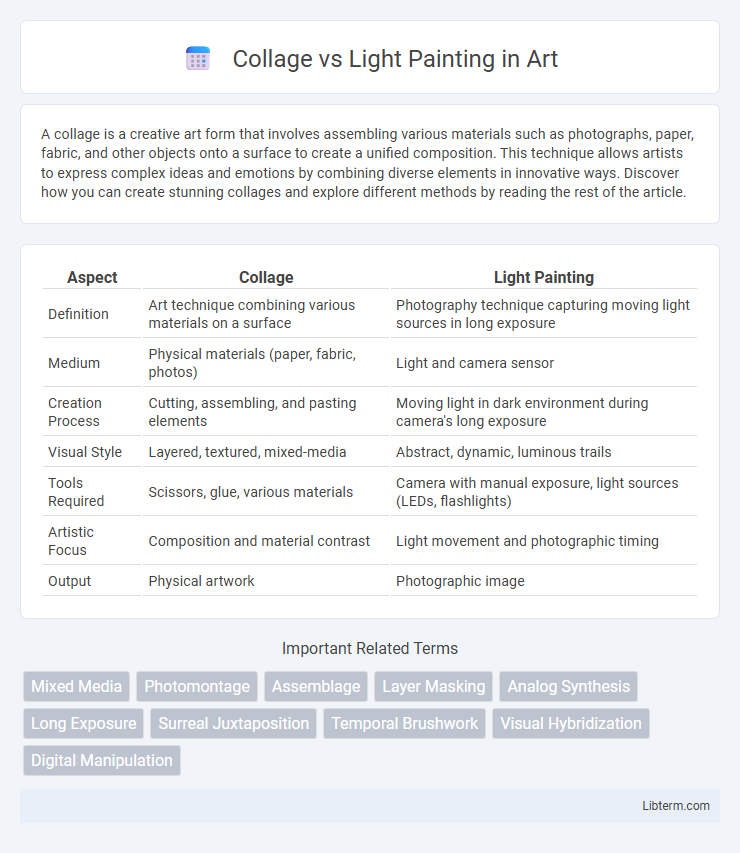A collage is a creative art form that involves assembling various materials such as photographs, paper, fabric, and other objects onto a surface to create a unified composition. This technique allows artists to express complex ideas and emotions by combining diverse elements in innovative ways. Discover how you can create stunning collages and explore different methods by reading the rest of the article.
Table of Comparison
| Aspect | Collage | Light Painting |
|---|---|---|
| Definition | Art technique combining various materials on a surface | Photography technique capturing moving light sources in long exposure |
| Medium | Physical materials (paper, fabric, photos) | Light and camera sensor |
| Creation Process | Cutting, assembling, and pasting elements | Moving light in dark environment during camera's long exposure |
| Visual Style | Layered, textured, mixed-media | Abstract, dynamic, luminous trails |
| Tools Required | Scissors, glue, various materials | Camera with manual exposure, light sources (LEDs, flashlights) |
| Artistic Focus | Composition and material contrast | Light movement and photographic timing |
| Output | Physical artwork | Photographic image |
Introduction to Collage and Light Painting
Collage is an artistic technique that involves assembling various materials such as paper, photographs, and fabric onto a single surface to create a unified composition. Light painting is a photographic method where moving light sources are captured with long exposure settings, resulting in dynamic and luminous images. Both techniques emphasize creativity and layering, but collage relies on tangible materials while light painting utilizes light as a medium.
Defining Collage: Techniques and Materials
Collage is an artistic technique that involves assembling various materials such as paper, photographs, fabric, and found objects onto a surface to create a unified composition. Techniques include layering, cutting, tearing, and adhering materials with glue or other adhesives to generate texture and depth. Common materials range from magazine clippings and newspaper to textiles and mixed media elements, allowing for diverse visual storytelling.
What is Light Painting? Methods Explained
Light painting is a photographic technique that involves moving a light source while taking a long exposure photograph, creating illuminated patterns or images that appear to be "painted" in the frame. Methods include using handheld LED lights, sparklers, and fiber optics to draw or shape light trails, often performed in dark settings to maximize contrast. This technique contrasts with collage, which combines various images or materials into a single artwork, as light painting captures time, movement, and light directly on camera.
Historical Background: Collage vs Light Painting
Collage originated in the early 20th century, pioneered by artists like Pablo Picasso and Georges Braque during the Cubist movement, revolutionizing art by assembling diverse materials into a unified composition. Light painting emerged in the 20th century as a photographic technique, with Man Ray and Picasso experimenting with long exposure and light manipulation to create dynamic, ephemeral images. Both methods reflect transformative artistic movements that challenged traditional representation through innovative use of materials and technology.
Artistic Processes Compared: Manual vs Digital
Collage as a manual artistic process involves physically assembling various materials like paper, fabric, and photographs, emphasizing tactile manipulation and layering to create texture and depth. Light painting, often executed digitally, relies on long-exposure photography combined with controlled light sources to capture ephemeral, dynamic images that can be further refined using photo editing software. Both techniques showcase unique creative workflows: collage prioritizes hands-on craftsmanship and materiality, while light painting integrates manual light manipulation with digital enhancement for a hybrid artistic expression.
Visual Impact and Aesthetic Differences
Collage art combines various materials and textures, creating layered visuals that evoke tactile richness and complex narratives, while light painting uses long exposure photography to capture fluid, luminous trails, resulting in ethereal and dynamic imagery. The visual impact of collage lies in its tangible depth and multifaceted composition, contrasting with the vibrant, transient glow and motion inherent in light painting. Aesthetic differences stem from collage's static, textured assemblage versus light painting's ephemeral, radiant strokes that redefine spatial perception.
Popular Artists in Collage and Light Painting
Popular artists in collage include Hannah Hoch, known for pioneering photomontage during the Dada movement, and Romare Bearden, celebrated for his vibrant African-American cultural narratives. In light painting, artists like Eric Staller and Tokihiro Sato have gained recognition for their innovative use of light to create dynamic, ephemeral images. Both mediums showcase a unique fusion of creativity and technique, with collage emphasizing assembled visuals and light painting focusing on photographic manipulation of light.
Common Applications in Modern Art
Collage and light painting are prominent techniques in modern art used to explore texture, composition, and visual storytelling. Collage commonly appears in mixed media artworks, graphic design, and contemporary installations, allowing artists to combine photographs, paper, and found objects to create layered narratives. Light painting is frequently utilized in photography, performance art, and digital media to create dynamic images through long exposure techniques, emphasizing movement and illumination in abstract or figurative forms.
Advantages and Challenges of Each Technique
Collage offers the advantage of combining diverse materials and textures, enabling unique visual narratives and tactile depth, but challenges include potential fragility and complexity in composition balance. Light painting allows for dynamic, vibrant effects with controlled illumination and movement, though it requires precise camera settings and can be hindered by environmental light conditions. Both techniques demand creativity and technical skill, yet collage emphasizes physical layering while light painting focuses on temporal light manipulation.
Choosing Between Collage and Light Painting
Choosing between collage and light painting depends on the desired artistic effect and medium preferences. Collage allows for layering diverse materials and textures to create tangible, mixed-media compositions, ideal for tactile, visually complex artworks. Light painting uses long-exposure photography to capture luminous trails and dynamic motion, perfect for experimental, ephemeral visual storytelling.
Collage Infographic

 libterm.com
libterm.com